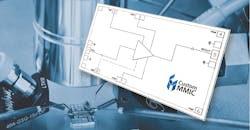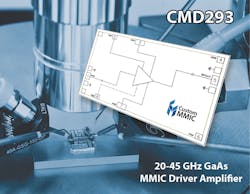Moving More MMICs to Market
Custom MMIC has picked up the pace even further in delivering new monolithic microwave integrated circuits (MMICs) to the industry. Following the company’s large number of product releases in 2018, Custom MMIC has already introduced various MMICs in the early part of this year. Customers can also be assured that more new products are on the way.
One of this year’s early arrivals is the CMD283 low-noise amplifier (LNA), which is the die version of the CMD283C3 LNA released last year. The CMD283 covers a frequency range of 2 to 6 GHz, delivering 27 dB of gain at 4 GHz and achieving a noise figure of 0.6 dB at the same frequency. It’s well-suited for electronic warfare (EW) and communications systems that require small size and low power consumption.
Continuing the same theme, Custom MMIC also introduced two other LNAs: the CMD298 and CMD299. The CMD298 spans a frequency range of 17 to 25 GHz. At 21 GHz, it provides about 27 dB of gain and attains a noise figure of 1.4 dB.
The CMD299 is an extremely broadband LNA—it covers a frequency range of 18 to 40 GHz. At 30 GHz, the CMD299 delivers around 17 dB of gain and achieves a noise figure of 3.5 dB.
Another new release of note is the CMD295 driver amplifier. Covering a frequency range of 2 to 20 GHz, this amplifier provides approximately 26.5 dB of gain at 10 GHz. The CMD295 also achieves an output 1-dB compression (P1dB) of +16 dBm at 10 GHz.
The CMD293 driver amplifier covers a frequency range of 20 to 45 GHz.
Sparking interest on this front is the CMD293 driver amplifier (see figure). Operating from 20 to 45 GHz, the CMD293 serves as a replacement part for the Avago AMMC-6345. At 30 GHz, the amplifier delivers 20 dB of gain and achieves a P1dB of +26 dBm.
Not to be outdone, the new CMD275 is the die version of the CMD275P4 low-phase-noise amplifier (LPNA). The CMD275 operates from dc to 26.5 GHz, and will find homes in military, space, and communication systems. At 10 GHz, the device offers 16 dB of gain and achieves a noise figure of 5.5 dB. Furthermore, at 10 GHz, the CMD275 achieves a saturated output power level of +20.5 dBm. And with a 10-GHz input signal, the amplifier’s phase-noise performance is −165 dBc/Hz at 10-kHz offset.
Lastly, the CMD297 is an analog phase shifter that operates from 5 to 18 GHz. It features a control voltage that ranges from 0 to 10 V, allowing the phase shift to be controlled over a 550-degree range at 7 GHz and a 240-degree range at 12 GHz.


